
What makes a hair transplant successful isn’t just visible growth. It is the harmony between planning, precision, and long term thinking. A strong result is about more than graft count or early photos. It’s built on a well-designed hairline, sustainable donor area management, and healing that respects both comfort and future goals.
In this article, we go beyond surface level expectations to explore what really shapes hair transplant success. From the method chosen to the medical team behind it, and from post-op care to natural hairline aesthetics, each section breaks down the details that separate a good outcome from a great one.
Defining Success in a Hair Transplant
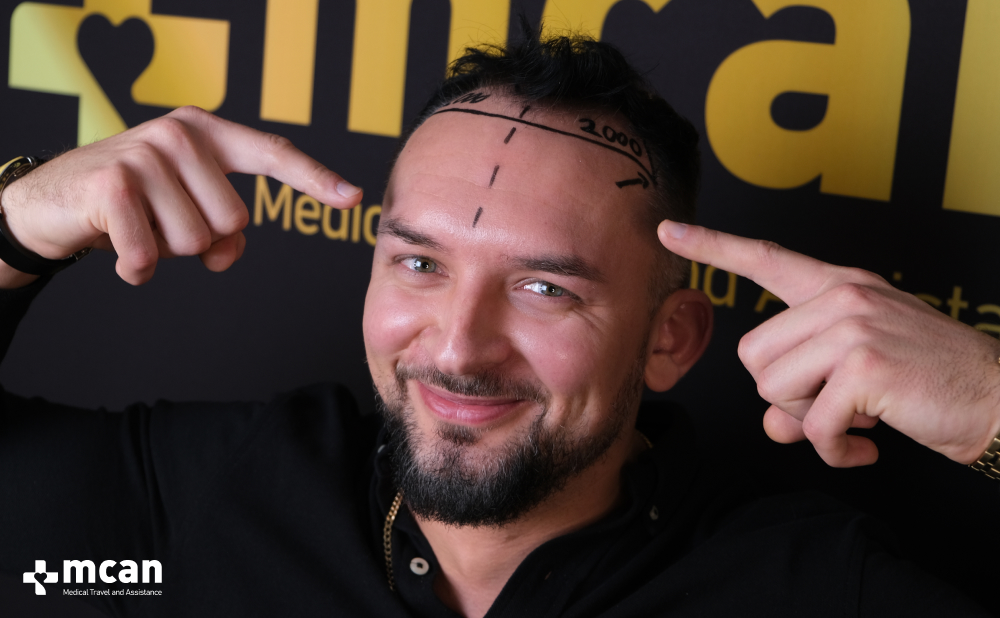
Success doesn’t look the same for every patient. While most people hope for fuller hair, the definition of a successful transplant depends on several realistic outcomes coming together.
What a Successful Hair Transplant Typically Includes:
- A natural looking hairline that suits your facial structure
- Even, healthy hair growth in both the recipient and donor areas
- Long term retention of implanted grafts
- Minimal visible scarring or signs of surgery
- High satisfaction with the final appearance
A good result is not only about how the hair looks at 6 or 12 months, but also how stable it remains over time. This is why experienced clinics often take future hair loss and donor area preservation into account during the planning phase. Without that, short-term gains may lead to long term regrets.

The Right Technique for the Right Case
Hair transplant success starts with choosing a method that fits the patient’s needs. Not every technique is suitable for every case, and a good clinic will recommend an approach based on hair loss pattern, donor area density, scalp condition, and long-term goals.
Common Techniques Used at MCAN Health:
- FUE (Follicular Unit Extraction): Ideal for most patients seeking natural results with minimal scarring. Follicles are extracted individually, leaving tiny dot-like marks in the donor area.
- DHI (Direct Hair Implantation): Suitable for those who want more control over hair direction and density. Grafts are implanted directly without the need for channel incisions.
- Sapphire FUE: A refined version of FUE that uses a sapphire blade for cleaner incisions. Often preferred for its potential to speed up healing and reduce trauma to the scalp.
Each of these techniques is minimally invasive and designed to deliver natural results, but choosing the right one is essential. For example, DHI may be a better option for patients seeking higher density in small areas, while standard FUE may work better for broader coverage.
Hair Transplant Success Starts with the Medical Team
Behind every successful hair transplant is more than just a method: There’s a team. From the surgeon’s initial planning to the precision of the graft implantation, every step requires experience and coordination.
Why Team Experience Matters:
- Hairline Design: A well designed hairline isn’t just about drawing a line. It has to consider facial structure, age, future hair loss, and how the result will look years down the line. That decision is made by the surgeon, and it sets the foundation for the entire transplant.
- Graft Handling and Placement: Once the follicles are extracted, they must be stored and implanted with care. Grafts are delicate and can easily be damaged by poor handling, long exposure to air, or rough placement. This part is often done by technicians, and their skill level directly affects how many grafts survive.
- Surgical Flow: A transplant session can last several hours. Fatigue, lack of focus, or miscommunication between team members can lead to errors. A trained, well organized team ensures consistency from start to finish.
- Post-Op Guidance: Even after the surgery is done, the success of the transplant still depends on daily decisions the patient makes. A clinic that offers clear, accessible guidance helps patients avoid complications that could affect healing or graft survival.
Donor Area Quality and Management: A Core Factor in Hair Transplant Success
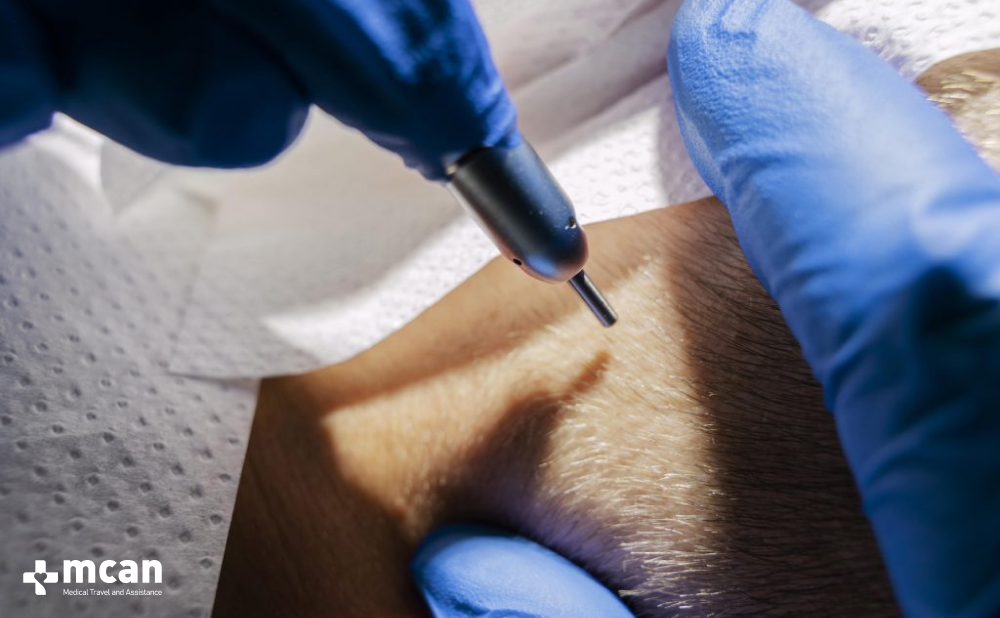
The donor area is where all transplanted hair comes from. If it’s not evaluated and managed correctly, even the best surgical technique won’t deliver the right results, and future options may be limited.
What Makes a Strong Donor Area?
- Sufficient Density: There needs to be enough healthy hair follicles to extract without leaving noticeable gaps.
- Stable Growth Pattern: A reliable donor zone should be resistant to further hair loss over time.
- Even Distribution: Harvesting must be done in a way that doesn’t thin out one area too much or create patchiness.
Surgeons assess not only how much hair is available, but how much can safely be used. Overharvesting may seem fine in the short term but can leave visible signs or reduce options for future sessions if hair loss progresses.
Donor Area Management Includes:
- Strategic spacing between extractions
- Alternating zones to prevent density loss
- Planning with long term results in mind, not just immediate coverage
For a hair transplant to succeed, the donor area must heal well, remain balanced, and be preserved for potential future use. Rushing to use every available graft often leads to regret later.
Post-Operative Aftercare: Where Hair Transplant Success Is Protected
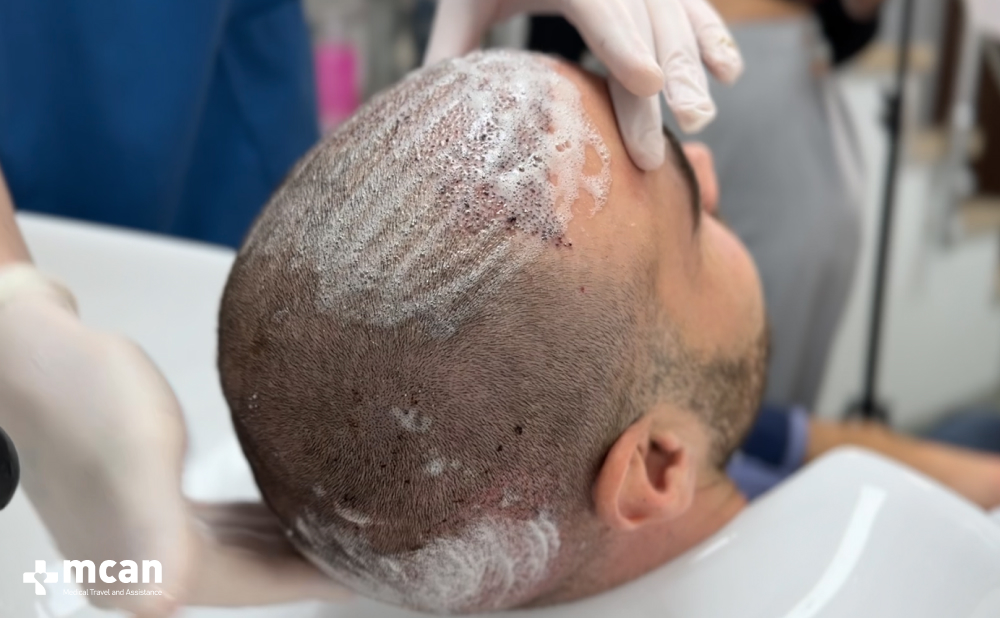
The surgery may be done in a day, but healing takes weeks, and this is where many outcomes are either protected or compromised. Even a perfectly performed procedure can fall short if aftercare is ignored.
Why Aftercare Matters:
- Grafts are delicate for the first 10–14 days
- The donor area is prone to irritation if not kept clean
- Infection, scab damage, or sun exposure can reduce graft survival
Key Aftercare Steps That Support a Successful Result:
- Washing: Begin gentle washing as advised by the clinic, usually around day 3–5. Never scrub or use hot water.
- Sleeping Position: Keep your head elevated for the first few nights to reduce swelling.
- Avoiding Trauma: No scratching, rubbing, or wearing tight hats.
- Sun Protection: Avoid sun exposure for several weeks. UV rays can darken healing skin and increase scarring.
- Clinic Follow-Up: Stay in contact with your medical team if any redness, itching, or unusual signs develop.
Even minor aftercare mistakes, like skipping washes or wearing a cap too early, can delay healing or harm grafts. Success depends not only on what’s done in the operating room, but what happens afterward, day by day.
Realistic Expectations and Planning: A Quiet but Crucial Part of Hair Transplant Success
A successful hair transplant doesn’t start in the operating room, it starts with a clear, well matched plan. Many patients are surprised to learn that getting the best possible result often means aiming for what’s right, not what looks most dramatic.
Every case is different, and the plan should reflect that. A clinic focused on long-term success will take the time to understand the patient’s needs, then shape a treatment strategy accordingly.
Here’s what a realistic plan often includes:
- A balanced hairline that suits the face and is placed with future hair loss in mind
- A sensible graft count based on donor area density and how much coverage is possible
- Consideration for age and progression, especially for younger patients who may need a staged approach
- Clear communication about what one session can realistically achieve
The Role of Clinic Infrastructure and Technology in Hair Transplant Success
While surgical skill is essential, the tools and environment that support the procedure matter just as much. A well-equipped clinic helps ensure that every step is done with precision and consistency.
Modern clinics use technology not to replace expertise, but to enhance it. You can see how these principles are applied in practice in MCAN Health’s hair transplant clinic, showcased in the video below, which highlights the modern facilities and advanced technology used to support successful results:
What Makes a Clinic Setup Contribute to Better Results:
- Specialized instruments like sapphire blades or fine punches minimize trauma and improve healing.
- Proper graft handling systems help prevent dehydration or damage before implantation.
- Ergonomic lighting and magnification allow for accurate angling, especially when working on the frontal zone or crown.
- Well organized surgical flow ensures that long sessions remain consistent from beginning to end.
| Infrastructure Element | Impact on Results |
|---|---|
| Sapphire blades | Cleaner incisions, potentially faster recovery |
| Graft hydration systems | Protect graft survival rate |
| High resolution magnifiers | Precise placement and angling of each graft |
| In-clinic nurse support | Better patient monitoring during and after surgery |
Natural Hairline Design: A Detail That Defines Success
No matter how well the grafts grow, if the hairline doesn’t look natural, the entire result can feel off. Hairline design is one of the most visible and lasting elements of a transplant, and it’s often what sets great work apart from average results.
This part of the procedure isn’t just technical, it’s artistic. It requires an understanding of how hair grows, how it frames the face, and how to balance aesthetic goals with long term practicality.
What Makes a Hairline Look Natural:
- It follows the natural curves of your face, rather than a straight or overly flat line.
- It uses single hair grafts at the very front, with denser groupings placed behind to mimic natural density.
- It includes irregularities and soft edges, rather than a rigid, artificial look.
- It’s designed with future hair loss in mind, avoiding overly aggressive placement.
| Poorly Designed Hairline | Well Designed Hairline |
|---|---|
| Straight, low, and too dense | Follows natural shape with soft density in front |
| Uses multi hair grafts in front | Single hair grafts placed at the edge |
| No consideration for aging | Adjusted for age and future loss patterns |
| Too symmetrical or sharp | Subtle irregularities add realism |
What Real Patients Say About Hair Transplant Success
When it comes to hair transplants, success isn’t just measured by numbers or grafts. It is seen in the mirror, felt in everyday confidence, and shared through real experiences. At MCAN Health, hundreds of patients have documented their journeys, and some of them offer a closer look at what true transformation looks like.
Here are three standout cases that highlight the impact of planning, technique, and care and what makes a hair transplant genuinely successful.
Juan M. – FUE, 4200 Grafts, 1 Year Result
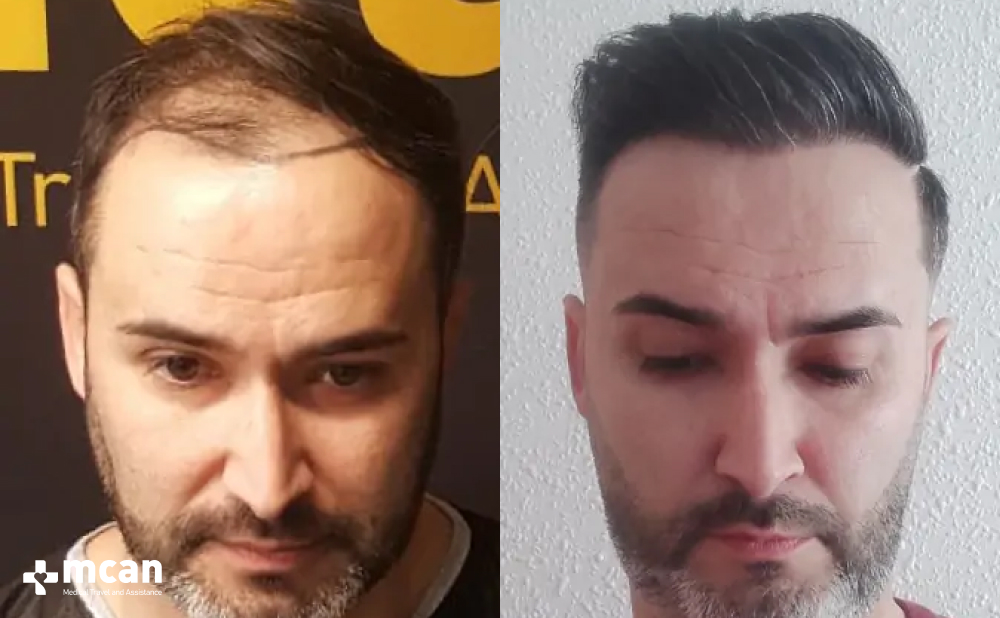
Juan, a 35 year old from Spain, came to MCAN Health with advanced hair loss in both the front and crown areas (Norwood Scale 5). With a strong donor area and clear long term goals, he was a candidate for a high graft count FUE procedure. After receiving 4200 grafts, his results at the one year mark were striking; a dense, natural hairline and full crown coverage that changed his overall look.
His case is a prime example of how graft density, proper donor management, and a patient-specific plan can combine for outstanding, long lasting results.
See full case: Juan M. – FUE, 4200 Grafts, 1-Year Result
Ignacio M. – DHI, 3000 Grafts, 6 Month Result
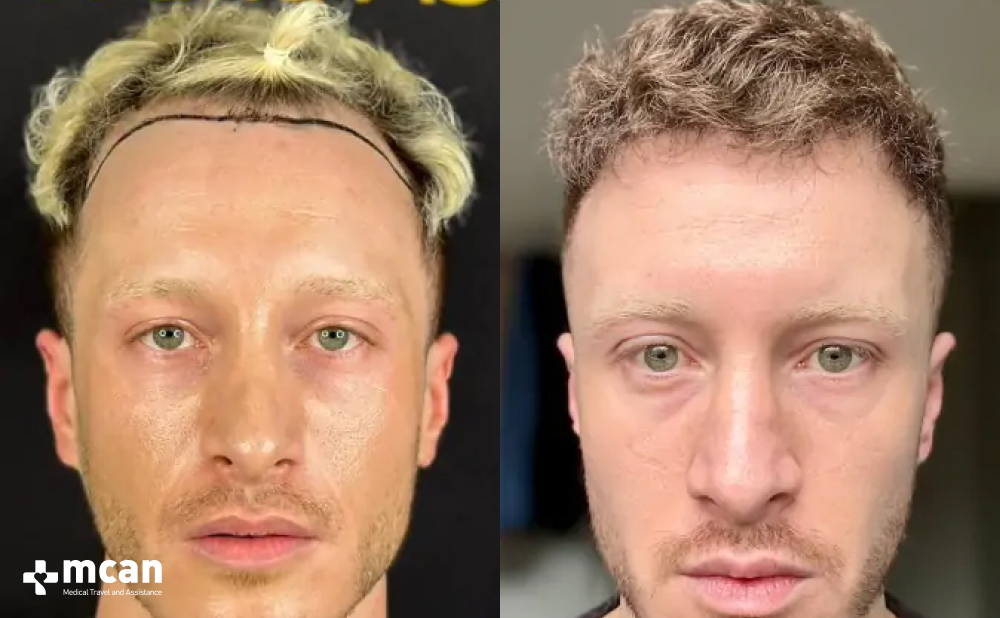
Ignacio, 32, showed early signs of recession, particularly in the frontal and temporal zones. Instead of waiting for further loss, he acted early and chose the DHI technique for precision and natural density. With 3000 grafts and a focus on a soft, realistic hairline, his transformation was already highly visible by month six.
Ignacio’s case shows how early intervention, paired with the right method, can deliver fast and natural-looking results, especially when a conservative hairline design is applied.
See full case: Ignacio M. – DHI, 3000 Grafts, 6-Month Result
Scott G. – FUE, 2750 Grafts, 8 Month Result
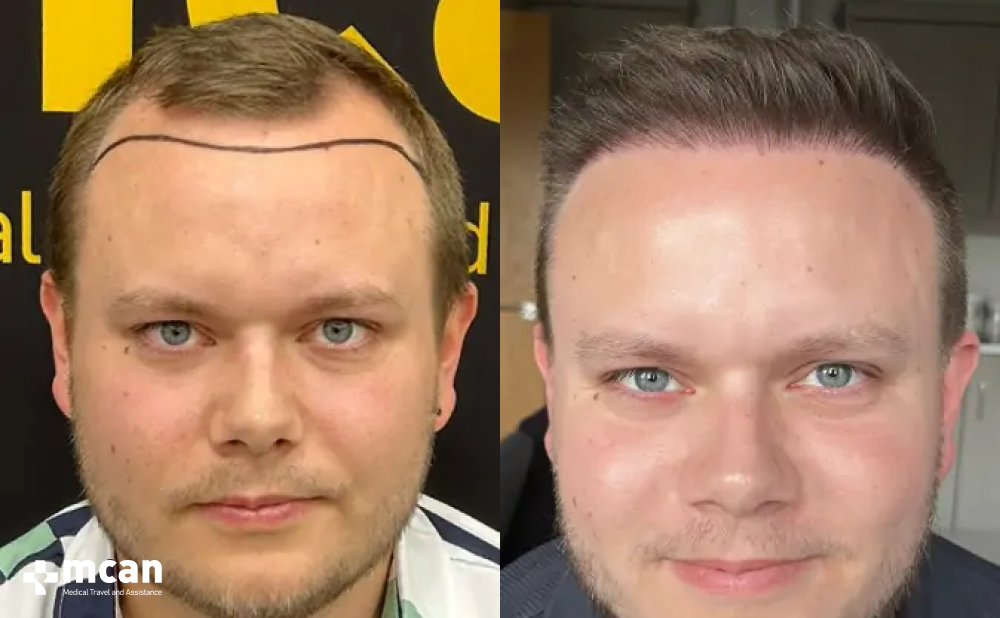
Scott, 41, experienced moderate thinning across the front and crown (Norwood Scale 3). He underwent an FUE procedure with 2750 grafts, aimed at restoring the front hairline and strengthening the mid scalp. By the 8 month mark, Scott had not only regained density but also achieved a more youthful appearance without overcorrection.
His case highlights how even a medium graft count, when placed strategically and matched to the patient’s age, can make a noticeable difference while keeping the result natural and balanced.
See full case: Scott G. – FUE, 2750 Grafts, 8-Month Result
Achieve Hair Transplant Success with Trusted Expertise in Turkey
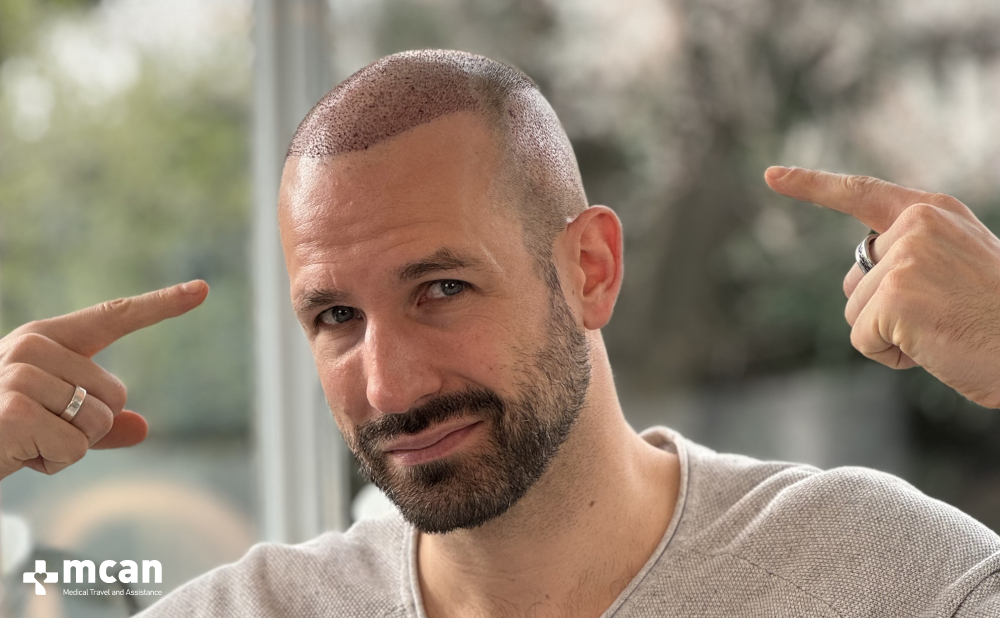
The success of a hair transplant doesn’t come down to a single factor. It’s the result of thoughtful planning, the right technique, experienced hands, and attentive aftercare. From natural hairline design to proper donor area management, every step plays a role and the results speak for themselves.
At MCAN Health, every procedure is designed with long-term success in mind. With internationally accredited standards, a skilled medical team, and patient specific planning, we focus on what truly matters: natural-looking results and smooth, confident recovery. From your first consultation through post-operative care, you’re supported at every step.
If you’re considering a hair transplant Turkey, MCAN Health offers the expertise, infrastructure, and follow-up care to help you achieve results that look and feel right, not just today, but for years to come.
Frequently Asked Questions About Hair Transplant Success
What truly defines hair transplant success?
It’s not just about covering bald spots. True success combines natural density, realistic hairline design, healthy graft survival, and long term consistency. It should look unnoticeably natural even to a barber.
How much does surgeon experience affect transplant success?
Significantly. An experienced surgeon knows how to balance extraction, manage grafts efficiently, and place them at natural angles. Skill makes the difference between just growing hair and growing it beautifully.
Can poor donor area planning reduce success in future sessions?
Yes. Overharvesting or uneven extraction can leave visible thinning and limit options for additional procedures. A successful plan always considers what may be needed later.
Is shock loss a sign of failure?
No, temporary shedding is part of the natural cycle after transplantation. It actually means the follicles are resetting as one of the steps toward eventual success. For more, see Hair Transplant Shedding Phase: Does Transplanted Hair Fall Out?
Does the clinic’s equipment impact the success of results?
Absolutely. Tools like sapphire blades, precision punches, and proper graft storage systems all help protect graft quality. Good equipment supports great outcomes.
How does aftercare influence hair transplant success?
Post-op care plays a direct role in whether grafts survive and heal properly. Ignoring instructions or disturbing the scalp early on can compromise even the best performed procedure.
Can scarring affect how successful the transplant looks?
If scars are large or uneven, they can impact how natural the donor area appears, especially with shorter hairstyles. Scarring should be minimal and well-healed. For details, visit Hair Transplant Scars: What You Need to Know
What role does hairline design play in long-term success?
It’s foundational. A hairline that’s too low, too flat, or too dense may not age well. A successful design respects your facial features, hair loss progression, and future needs.
Does following a recovery timeline improve success rates?
Yes. Understanding when to expect shedding, regrowth, and final results helps patients support healing at each stage. See Hair Transplant Timeline: A Guide to Hair Transplant Recovery & Growth Chart
Can I expect instant results from a successful hair transplant?
No. Even the most successful cases take months to develop. Final outcomes are typically seen between 12 and 18 months but the foundation for that success is laid from day one.
 Crown Hair Transplant: Causes of Balding Crown and Treatment Options
Crown Hair Transplant: Causes of Balding Crown and Treatment Options  Hair Transplant Scabs: Timeline to Expect Week by Week
Hair Transplant Scabs: Timeline to Expect Week by Week  Do You Need a Breast Lift, Breast Reduction or Both?
Do You Need a Breast Lift, Breast Reduction or Both?